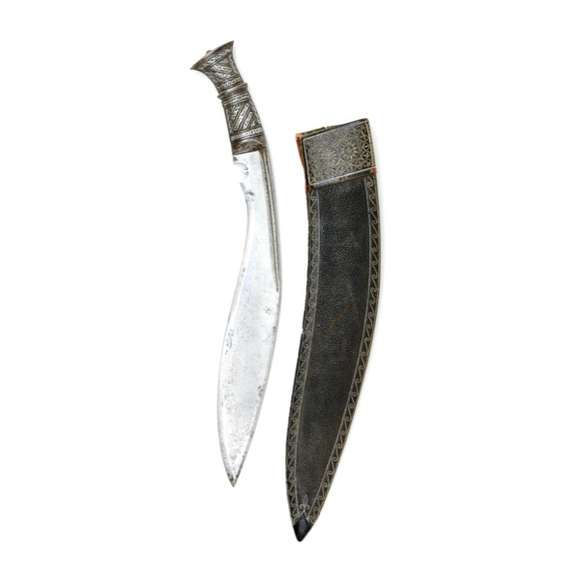Thought to have been presented by the Royal House of Nepal.

Sheathed 44 cm
Khukurī 39.6 cm
29 cm
Base 7.5 mm
Shoulder 7 mm
5 cm from tip 3.5 mm
Base 26 mm
Widest at belly 50 mm
361 grams
9 cm from hilt
Iron, steel, brass, silver, wood, leather, plant fiber thread
Nepal
Early 20th century
UK antique market
Description
An unusual variety of kothimora khukurī. Typical 20th-century blade with pointed shoulder, relatively wide belly, and deep, nearly symmetrical notch. It has a bronze bolster.
The hilt is carved from black buffalo horn, the first section is conventionally shaped, up to the ring typically carved that separates grip from pommel. From then on, the hilt is carved in a stylized animal head, judging from the curly manes, a lion. The designs are repeated in the hilts of the karda and cakmak, in this case the front paws are also included into the design.

The kothimora scabbard has a beautiful silver top mount with repousse decoration in high relief. The center shows a kīrtimukha (कीर्तिमुख), literally "face of glory". An all-devouring monster that is used across Asia as an auspicious decorative element that is supposed to consume evil. According to legend it was created from Shiva's third eye to consume a demon named Rahu. Once summoned, Shiva decided to spare Rahu and ordered kīrtimukha to consume its own body instead. The motif is frequently seen on temple gates, consuming all evil.

The scabbard body of made of wood, covered with smooth dark brown leather. The silver chape is engraved with floral designs. Apart from the karda and chakmak it carries two khisā in an enlarged back pocket.
Animal pommels on khukurī
A very rare feature that I have only seen before on a khukurī that was presented by Maharaja Jung Bahadur (1816-1877), ruler of Nepal, to Sir John Login (1809-1863), governor of Lahore in 1849. It is now in the Royal Armories collection, accession number XXVID.45 A. Another more conventional khukruī has the karda and cakmak hilts caved in lion faces. It was also presented by Maharaja Jung Bahadur, to the East India Company in 1851. Victoria & Albert Museum, accession number 2561(IS).
These examples date from the early 19th century and are of far superior quality. However, it shows the carving of animal head hilts on khukurī has a longer history.
Condition
Blade with a nick in the edge. Some staining. Otherwise the whole is in pretty good condition. See photos.













An understated, elegant khukuri of substantial proportions with fine layered blade.
With iron, silver overlaid hilt. Its associated scabbard features fine quillwork.
Early type with very shallow notch in the blade and little flare in the pommel.






